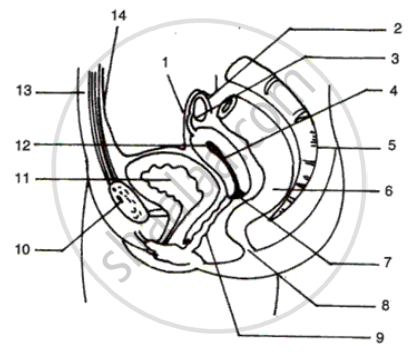Advertisements
Advertisements
प्रश्न
The below diagram is of a developing embryo is a mother’s womb:

(i) Write the functions of the placenta, amnion, and umbilical cord.
(ii) How are the waste products of a fetus removed?
(iii) What is the gestation period?
उत्तर
(i) Functions:
1. It supplies oxygen, water, nutrients and hormones from the mother to embryo.
2. It transfers. carbon dioxide and other waste materials from the embryo to the mother’s blood.
3. It shields the embryo from infections as it is impermeable to most of the microorganisms present in the mother’s blood.
4. It produces certain hormones like oestrogen and progesterone which are essential for the reproductive process.
The amnion or amniotic sac is made up of protective membranes that are formed around the embryo. It encloses a fluid-filled space which acts as a water-bath and excellent shock absorption for the young embryo.
5. The embryo that develops in the placenta is maintained at a constant temperature, is well protected and nourished by the umbilical cord.
(ii) Waste products of the fetus are removed through the umbilical cord.
(iii) The interval of time between fertilization and birth is called the gestation period. It is about 280 days in human beings.
APPEARS IN
संबंधित प्रश्न
Explain the process of development in human beings.
Explain the process of birth in human beings.
Newly formed DNA copies may not be identical at times. Give one reason.
State the exact location of the Proximal convoluted tubule.
Draw a labelled diagram of the human male reproductive system. With the help of this diagram, describe the working of human male reproductive system?
During adolescence, several changes occur in the human body. Mark one change from the following associated with sexual maturation in boys.
Draw a diagram of human female reproductive system and label the part.
(i) That produces eggs.
(ii) Where fusion of egg and sperm take place.
(iii) Where zygote is implanted.
What happens to human egg when it is not fertilized?
Diagram shows the reproductive system of female human beings:
(i) Name the parts numbered 1 to 14.
(ii) Normally, after how many days does an ovary release an egg?
(iii) Where are the sperms released during coitus?
(iv) What is the role of sperms after their ejaculation in vagina?
(v) What is the function of the organ numbered 5?
(vi) What is the gestation period in human?

Multiple Choice Question:
What will happen if the temperature of the scrotal sacs temporarily goes to about 2°C lower than body temperature?
Given below are the events in human reproduction. Write them in correct sequential order.
Insemination, gametogenesis, fertilisation, parturition, gestation, implantation
